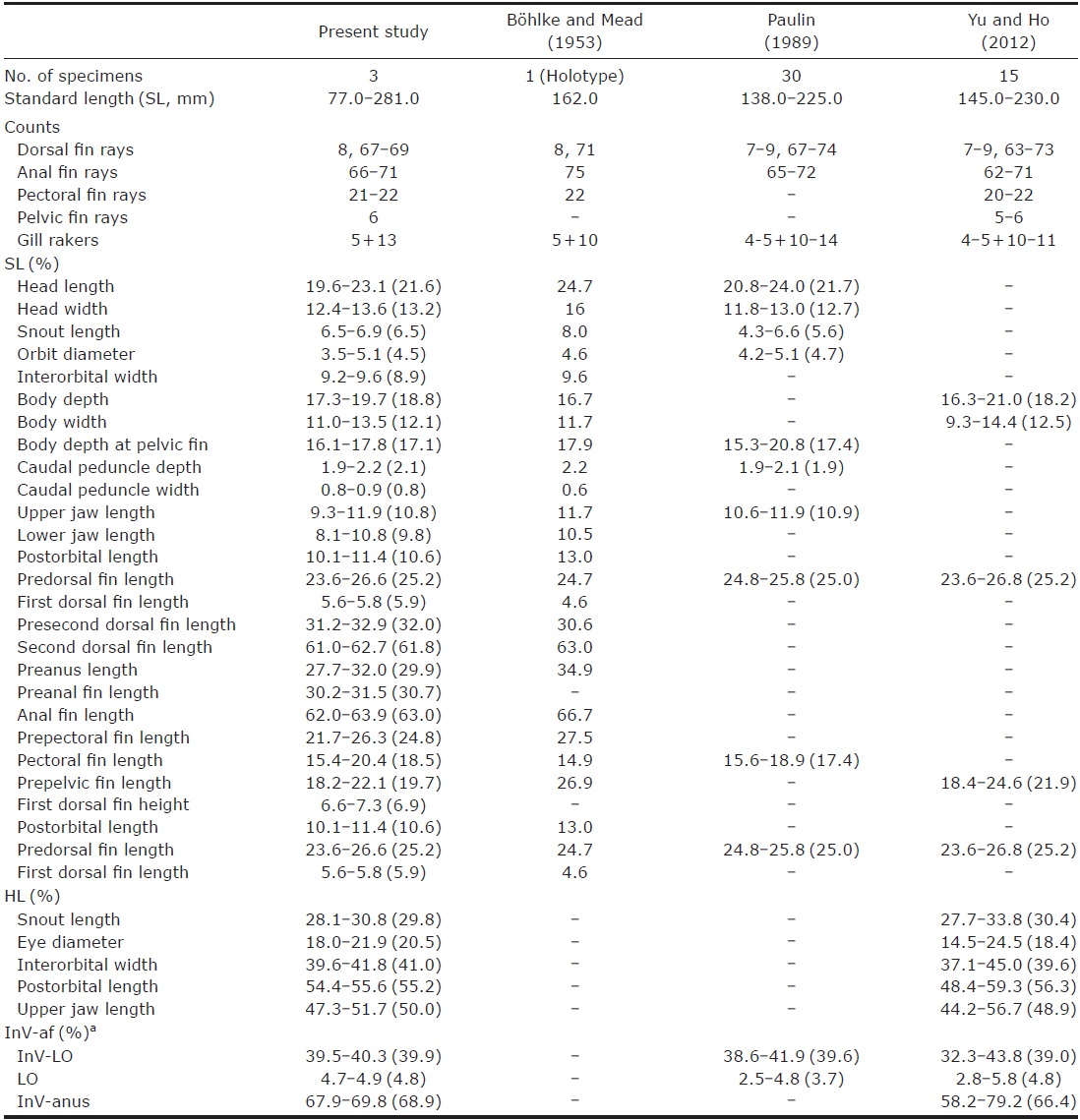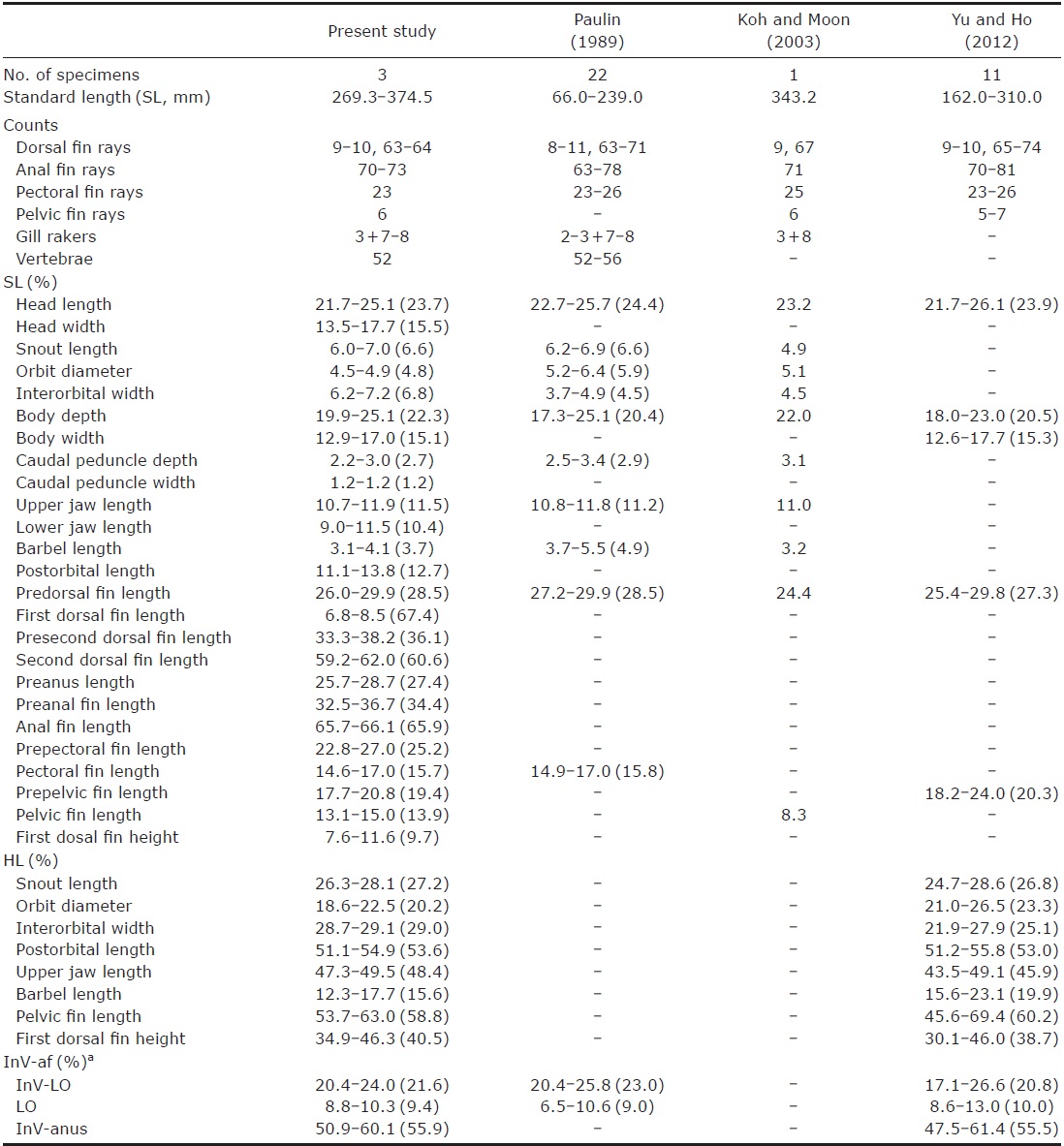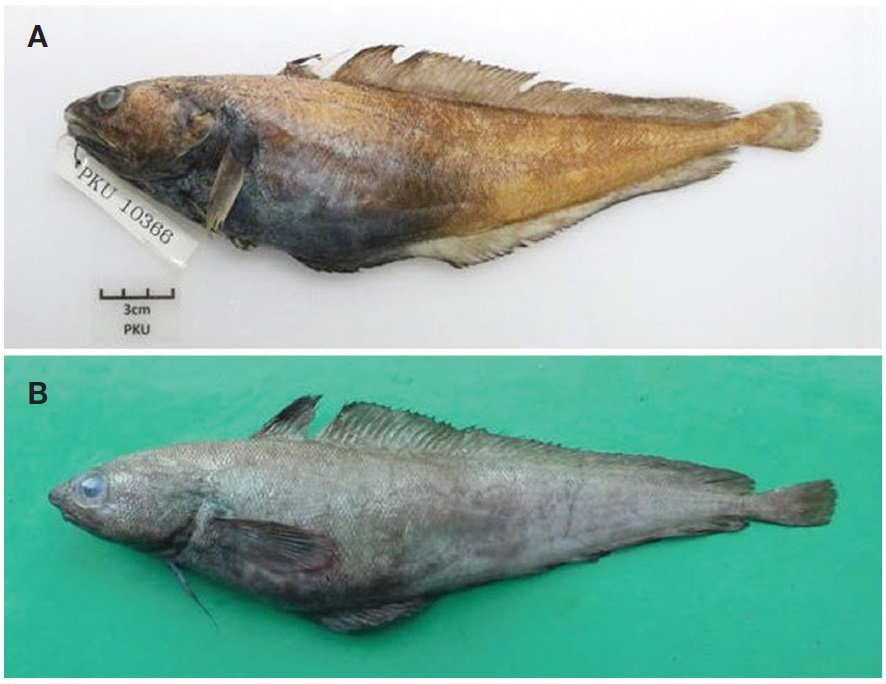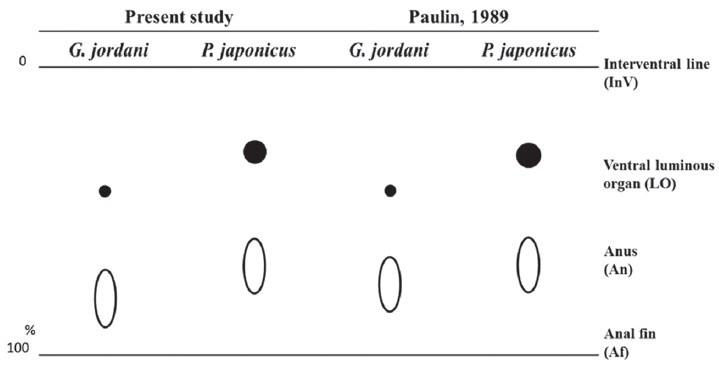The family Moridae in the order Gadiformes comprises 107 species of 18 genera worldwide (Eschmeyer and Fong, 2015). In Japan, 17 species of 8 genera are currently known (Nakabo, 2013), and three species, each belonging to different genera, are found in Korea (Kim, 2011) including Laemonema nana Taki, 1953, Lotella phycis (Temminck and Schlegel, 1846), and Physiculus japonicus (Hilgendorf, 1879). They are distributed worldwide from shallow coastal areas to deep waters (beyond 2,500 m), and less potential value to the fishery except in New Zealand and Australia (Cohen et al., 1990). Fishes of the family Moridae were placed in the family Gadidae until Svetovidov (1948) recognized a distinct family Moridae, based on the uniqueness of the anterior paired projections of the swim bladder connected to the rear of the skull. Among these, four genera (Gadella, Physiculus, Tripterophycis, and Salilota) have a ventral luminous organ (Paulin, 1989; Cohen et al., 1990; Nelson, 2006).
The genus Gadella Lowe, 1843 is differs from other genera by the lack of a barbel on the lower jaw and the diameter and position of the ventral luminous organ (Lowe, 1843; Paulin, 1989). The genus Physiculus Kaup, 1858 is similar to the genus Gadella in some morphological characteristics: ventral luminous organ in advance of the anus, two dorsal fins. But can be distinguished from it by the presence of a barbel on the lower jaw (Paulin, 1989). Recently, two morid specimens were collected by trawl net from the East Sea and Jeju Island in Korea, and were identified as Gadella jordani (Böhlke and Mead, 1951) using both morphological and molecular methods. This species has never officially been included in Korean fish fauna. Here, we describe its detailed morphological characteristics to suggest new Korean names of genus and species.
In Korea, P. japonicus was first reported by Koh et al. (1999) based on a single specimen, thereafter, the morphological characteristics of this species in Korea have not been studied since then. Therefore, we redescribe P. japonicus in detail based on three Korean specimens collected from the East Sea and Jeju Island, Korea in 2013-2014.
Two specimens of G. jordani were collected by bottom trawl from the East Sea and the northeast coast of Jeju Island, Korea. Three specimens of P. japonicus were also collected from the East Sea and Jeju Island, Korea, by trawl and set net in 2013-2014. These specimens were fixed in 10% formalin and preserved in 70% ethanol. Counts and measurements followed Hubbs and Lagler (2004), using a vernier caliper to the nearest 0.1 mm. The vertebrae were counted from a radiograph (Softex HA-100, Japan). The size and position of the ventral luminous organ were measured with the methods of Paulin (1989). These specimens were deposited at the Ichthyology Laboratory at Pukyong National University (PKU), and the Fisheries Resources Laboratory, East Sea Fisheries Research Institute (ESFRI), Korea.
The molecular identification of G. jordani was performed with primer pair VF2 (5′-TCAACCAACCACAAAGACATTGGCAC-3′) and FishR2 (5′-ACTTCAGGGTGACCGAAGAATCAGAA-3′), which amplify the mitochondrial DNA (mtDNA) cytochrome c oxidase subunit I gene (COI) (Ward et al., 2005). The genomic DNA was extracted from muscle tissue using the AccuPrep Genomic DNA Extraction Kit (Bioneer, Daejeon, Korea). A polymerase chain reaction (PCR) was performed in a total volume of 30 μL containing 3 μL of DNA template, 2.4 μL of dNTPs, 3 μL of 10× buffer, 0.1 μL of Taq DNA polymerase, 1 μL of forward primer, 1 μL of reverse primer, and distilled water. The PCR consisted of initial denaturation at 95°C for 1 min, 35 cycles of 95°C for 1 min, 52°C for 1 min, and 72°C for 1 min, followed by final extension, 72°C for 5 min. The PCR products were purified using the Davinch DUO Purification Kit (Da vinch-K, Seoul, Korea). The PCR products were sequenced with an ABI 3730XL DNA Analyzer and the ABI Prism BigDye Terminator v3.1 Ready Reaction Cycle Sequencing Kit (Applied Biosystems, Foster City, CA, USA). The sequences were aligned by CLUSTAL W (Thompson et al., 1994) in the BioEdit (ver. 7) (Hall, 1999). The sequences of G. imberbis (GeneBank accession No. KC015368) from the National Center for Biological Information database were used for the sequence comparison. We also obtained the mitochondrial COI sequence of P. japonicus (PKU 8358, Korea) for outgroup. A neighbor joining tree (Saitou and Nei, 1987) was constructed using the Kimura two-parameter model (Kimura, 1980) in MEGA 5 (Tamura et al., 2011).
Diagnosis. Body elongated and compressed; snout broad, obtusely rounded; teeth variable; no vomerine teeth; no barbel on lower jaw; pelvic fins with two outermost rays filamentous; ventral luminous organ in anterior to anus; scales small, cycloid, covering entire body but not on snout; otoliths spindle shaped, inside straight (Lowe, 1843; Paulin, 1989).
Remarks. In the genus Gadella, 14 species have been reported in the world (Sazonov and Shcherbachev, 2000). They are distinguished from all other genera by having no barbel on the lower jaw (Lowe, 1843; Paulin, 1989; Trunov, 1992; Okamoto et al., 2010).
Material examined. One specimen, 281.0 mm in standard length (SL), collected by bottom trawl net, at 129-148 m depth, Hupo, Uljin, East Sea, Korea (36°43.30′N, 129°32.81′ E), 5 May 2013, ESFRI 1106; one specimen, 119.7 mm SL, collected by bottom trawl net, northeast coast of Jeju Island, Korea, 27 Oct 2014, PKU 11461.
Comparative material examined. One specimen, 77.0 mm SL, collected by trawl net, Suruga Bay, Japan (35°00.194′N, 138°22.497′E), 27 Nov 2013, MSM-15-13.
Description. Counts and measurements as shown in Table 1. Body slim and elongated (Fig. 1). Tail compressed; very narrow caudal peduncle. No V-shaped ridge on top of skull; dorsal margin of head slightly sloping; snout short and rounded; mouth large and terminal; posterior tip of maxilla reaching to posterior margin of eye; no barbel on lower jaw; teeth villiform, small, equal size, arranged in 3-5 rows on both jaws; no vomerine teeth; eyes small; interorbital space wider than eye diameter; two pairs of nostrils, circular shape. Gill slit large; posterior margin of opercle not reaching to origin of pectoral fin. Lateral line extending from opercular flap to base of caudal fin. Fins lack spines; origin of first dorsal fin vertically above upper end of gill opening; first dorsal fin ray not elongated; origin of second dorsal fin begins vertically above base of anal fin; second dorsal fin and anal fin same in height; posterior margin of pectoral fin extending until base of anal fin; pelvic fin with outermost two rays filamentous, beginning under lower base of pectoral fin; anal fin not notched; caudal fin slightly rounded, separated dorsal and anal fin rays. Ventral luminous organ small and placed closer to anus than to interventral line. Anus anterior to origin of anal fin. Head and body covered with cycloid scales, except for lower position of snout, branchiostegal membranes, vertical fin membranes, ventral luminous organ (ESFRI 1106, PKU 11461).
Color. When fresh: body reddish-brown dorsally and bluish ventrally, undersides of head and abdomen bluishblack; lips, tip of tongue, branchiostegal membranes, and gill rakers blackish; all fins transparent, with dark spots on dorsal and anal fin membranes; posterior margin of caudal fin dark brown (Fig. 1). In ethanol: body yellowish-brown; undersides of head and abdomen blackish; lower jaw blackish; all fins transparent.
Distribution. East Sea (Uljin) and Jeju Island, Korea (present study); Japan (Okamoto et al., 2010); China (Chinese Academy of Fishery Science, 2007); Taiwan (Shao, 1997); Australia (Hoese et al., 2006); Fiji (Seeto and Baldwin, 2010).
Remarks. The examined specimens were identified as G. jordani based on the lack of a barbel on the lower jaw, no vomerine teeth, and a ventral luminous organ positioned closer to the anus than to the interventral line (Paulin, 1989). Most of the characteristic counts and measurements of the original description (Böhlke and Mead, 1951) correspond well to those of our specimens (Table 1). Böhlke and Mead (1951) placed this species in the genus Physiculus based on the lack of vomerine teeth and the position of the ventral luminous organ. However, Paulin (1989) suggested that this species be placed in the genus Gadella based on the following traits: ciliform teeth on both jaws, ventral luminous organ very small and closer to the anus than to the interventral line, and no barbel on the lower jaw. Three species of the genus Gadella have been recorded in the North Pacific: G. edelmanni (Brauer, 1906), G. jordani (Böhlke & Mead, 1951), and G. molokaiensis Paulin, 1989 (Nakabo, 2013). Of these, G. molokaiensis is known only from the Hawaiian Islands (Paulin, 1989; Okamoto et al., 2010). Gadella jordani and G. molokaiensis can be distinguished by snout length in SL (7.0%-7.9% in the former vs. 4.3%-6.6% in the latter), head length in SL (20.8%-24.0% in the former vs. 25.3%-29.1% in the latter), orbit diameter in SL (4.2%-5.1% in the former vs. 5.1%-5.8% in the latter), maxillary length in SL (10.6% -11.9% in the former vs. 12.6%-14.8% in the latter) (Paulin, 1989). However, Sazonov and Shcherbachev (2000) suggested that G. molokaiensis cannot be clearly distinguished from G. jordani and that the two species might be synonymous (Sazonov and Shcherbachev, 2000; Okamoto et al., 2010). Taxonomic characters of two species suggested by Paulin (1989) may be insufficient to identify the two species. Therefore, further studies on morphological and molecular differences of the two species are necessary. Gadella jordani and G. edelmanni can be distinguished by second dorsal fin rays (67-74 in the former vs. 63-65 in the latter), anal fin rays (65-72 in the former vs. 64-68 in the latter), gill rakers (4-5+10-14 in the former vs. 2+10-11 in the latter), diameter of the ventral luminous organ in InV-af (2.5%-4.8% in the former vs. 4.4%-7.0% in the latter) (Paulin, 1989). Except for the genus Gadella, G. jordani is similar to P. japonicus in some morphological characters, including its round head, two dorsal fins, no vomerine teeth, the origin of the 2nd dorsal fin is vertically above the origin of the anal fin, and the ventral light organ is anterior to the anus (Fig. 1) (Paulin, 1989; Koh and Moon, 2003; Okamoto et al., 2010; Nakabo, 2013). However, the two species are clearly distinguished by the presence or absence of a barbel on the lower jaw (absent in the former vs. present in the latter), the diameter of the ventral luminous organ in InV-af (2.5%-4.8% in the former vs. 6.5%-10.6% in the latter), the position of the ventral luminous organ (closer to the anus than to the interventral line in the former vs. generally equidistant between the interventral line and the anus in the latter), and the size of the teeth (equally sized in the former vs. the outer raw teeth are generally larger than the inner teeth in the latter) (Tables 1, 2, Figs. 2, 3) (Paulin, 1989; Koh and Moon, 2003; Yu and Ho, 2012). To identify the species exactly, we compared a 466-base pair mitochondrial DNA COI sequence in Japan G. jordani. The sequences in 2 specimens from this study corresponded well with the sequence in specimen from Japan (genetic distance, d=0.005-0.007) (Fig. 4). Thus, these specimens were identified as G. jordani based on morphological and molecular analyses. We propose a new Korean name “Min-su-yeom-dae-gu-sok” for the genus Gadella and “Minsu-yeom-dae-gu” for G. jordani.
Material examined. One specimen, 362.0 mm SL, collected by set net, Daejin, Goseong, East Sea, Korea, 12 Feb 2013, ESFRI 907; one specimen, 374.5 mm SL, collected by set net, Sokcho, East Sea, Korea, 14 Mar 2013, PKU 8358; one specimen, 269.3 mm SL, collected by trawl net, Jeju Island, Korea, 10 Mar 2014, PKU 10366.
Description. Counts and measurements shown in Table 2. Body slim and elongated (Fig. 2). Narrow caudal peduncle; tail compressed; head and abdominal region are laterally compressed. Head moderately large and anterior slightly vertically depressed; no V-shaped ridge on top of the skull; snout rounded and protrudes slightly beyond the upper jaw; mouth large and subterminal; posterior tip of maxilla reaching to posterior margin of the eye; short barbel on lower jaw, shorter than orbit diameter; teeth conical, small, arranged in 4-5 rows on both jaws; outer premaxillary teeth somewhat larger than inner; no vomerine teeth; eyes moderately small; interorbital space wider than eye diameter; two pairs of nostrils, circular shape. Posterior margin of opercle not reaching to origin of pectoral fin; lateral line extending from opercular flap to middle of the second dorsal fin; fins lack spines; origin of the first dorsal fin posterior to and vertically above base of pectoral fin; first dorsal fin rays not elongated; origin of second dorsal fin posterior to margin of pectoral fin; pelvic fin begins anterior to base of pectoral fin, outermost two rays filamentous; anal fin not notched. Ventral luminous organ moderately large, generally positioned midway between interventral line and anus; caudal fin slightly rounded, separated in the dorsal and anal fin rays. Head and body covered with cycloid scales, except for the suborbital region, lower position of snout, branchiostegal membranes, vertical fin membranes, and ventral luminous organ (Table 2, Figs. 2, 3).
Color. When fresh: body reddish-brown; undersides of head and abdomen bluish-black. Lips dark brown; branchiostegal membranes and gill rakers blackish; all fins reddish-brown, posterior margins of dorsal, anal, and caudal fins blackish (Fig. 2). In ethanol: body brownish-yellow; undersides of head and abdomen blackish; all fins are pale.
Distribution. East Sea (Sokcho and Goseong) and Jeju Island, Korea (present study; Koh and Moon, 2003); Japan (Cohen et al., 1990); China (Chinese Academy of Fishery Science, 2007); Taiwan (Shen et al., 1993).
Remarks. As shown in Table 2, the morphological characteristics of these specimens in the present study correspond well with those of the previous studies (Paulin, 1989; Koh and Moon, 2003; Yu and Ho, 2012). In Japan, six species of the genus Physiculus have been recorded: P. japonicus Hilgendorf, 1879, P. chigodarana Paulin, 1989, P. maximowiczi (Herzenstein, 1896), P. nigripinnis Okamura, 1982, P. rhodopinnis Okamura, 1982, and P. yoshidae Okamura, 1982 (Nakabo, 2013). Of these, P. japonicus and P. chigodarana are easily distinguishable by the height of the first dorsal fin (equal to the height of the second dorsal fin in the former vs. higher than the second dorsal fin height in the latter) (Paulin, 1989; Nakabo, 2013). Physiculus japonicus is distinguishable from P. nigripinnis in the number of first dorsal fin rays (9-10 in the former vs. 6-8 in the latter), the color of the dorsal and anal fins (reddish-brown in the former vs. black in the latter); from P. rhodopinnis in the number of first dorsal fin rays (9-10 in the former vs. 6-7 in the latter), the color of the dorsal fins (uniformly reddish-brown in the former vs. lower halves black in the latter); from P. yoshidae in the number of first dorsal fin rays (9-10 in the former vs. 6-7 in the latter), the number of anal fin rays (60-71 in the former vs. 70-77 in the latter), position of the ventral luminous organ (generally midway between the interventral line and the anus in the former vs. closer to the anus than to the interventral line in the latter) (Paulin, 1989; Nakabo, 2013). Physiculus japonicus is most similar to P. maximowiczi in its external shape, but differs in the size of the teeth (outer raw teeth larger than inner in the former vs. equal in the latter), and the presence or absence of gular scales (generally absent in the former vs. present in the latter) (Svetovidov, 1967). However, Cohen (1979) examined the holotypes of P. japonicus and P. maximowiczi and noted that they were quite similar, and suggested that they probably represent the same species. Paulin (1989) later mentioned that P. maximowiczi was a synonym of P. japonicus, but the identification of the two species was not yet confirmed (Eschmeyer, 1998). Therefore, further research is required to resolve the taxonomic confusion of these two species.
Korean name:1*민수염대구속, 2*민수염대구















